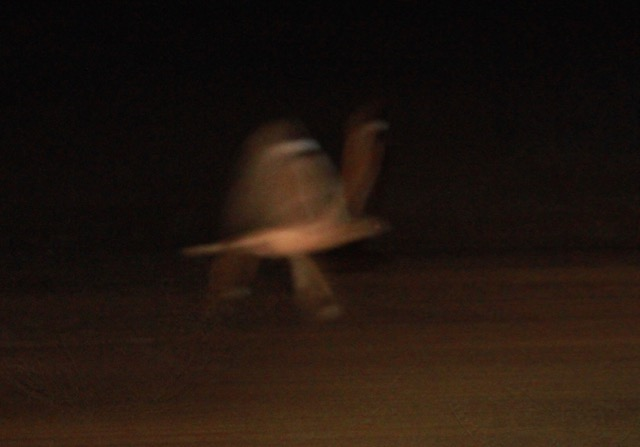The start of a golden era?
(note: apologies for the poor photography in this post, if it was not for the critical nature of the images they would not have been included!)
For ten years we have been visiting Western Sahara, an area right on the periphery of the Western Palearctic. Richard Moores’ first visit discovered a previously unknown population of African Dunn’s Lark (Eramalauda dunni) and since then we have continued to expand the understanding of mammals and birds in the region. Despite the complete collapse of larger mammal populations over the last 50 years, most bird species are still present and given the position of the area on the western edge of the Sahara, the possibility of new species for the Western Palearctic has always been in the back of our minds, including the potential for Golden Nightjar Caprimulgus eximius….
In March 2016 we returned to Western Sahara to collect in camera traps that we had deployed in 2015, as well and deploy ten new cameras and a number of bat detectors in massifs around the territory including the Adrar Soutouf in the remote interior. Just prior to leaving the UK we heard that an unidentified nightjar had been recorded near Oued Jenna on the Aousserd road. In May 2015 a team of birders visiting the area discovered the first Golden Nightjar for the Western Palearctic after accidentally hitting and killing it with their car (read more about this here). With knowledge of both last years’, and the recent nightjar events we went mentally prepared.
Our already jam-packed schedule took a blow on the first night with only one of the three hold-bags arriving with us at Dakhla airport, and a complete no-show by the car hire company. With increased time pressure, we still achieved all we needed to in the first couple of days but it didn’t allow for any birding time, especially not in the ‘right’ areas. It wasn’t until the penultimate evening, 16th March 2016, that we headed south down Aousserd road at dusk. As per usual we spot-lit for about 100km observing several each of Rüppell’s Fox (Vupes rueppellii) and Fennec Fox (Vulpes zerda) and at km137 a nightjar species flew across the road (our first nightjar in five visits). Views were brief as it headed through the headlights and as we tracked it with our spotlight until it melted into the darkness the resounding impression was of a plain bird with large white wing and tail flashes. Despite waiting for 30 minutes or so, there was no further sign of this bird in the area. Later on as we approached Oued Jenna another nightjar flashed through the headlights, identical to the first and dropped onto a flat stony area. A series of short flights again gave a very encouraging impression and within seconds it had settled on the side of the road where it promptly started singing – Golden Nightjar! It was a particularly brief bout of singing before it took off into the darkness. We rapidly connected up the iPhone and played the Golden Nightjar song recording out into the blackness. Out of nowhere a male jinked in, almost making it into the passenger seat before alighting briefly near the car. Trying to secure images of the bird proved frustrating and almost impossible, as the images allude to!.
One of only two images we secured of the bird on the ground but enough to be able to see the plain and warm golden-brown colouration, lacking any distinct contrast or markings.
Despite the awful image the black-white-black wing tip pattern is clearly visible as is the lack of any dark leading edge to the wing and the overall warm colouration.
As we stood and listened a further two birds could be heard singing in close vicinity. They clearly favoured areas of open ground, loose sand and scattered grasses rather than the acacia-filled oued. This represents the second record for the Western Palearctic and the first of possible breeding. The winter of 2015/2016 appears to have been exceptional in the region with extensive rains causing a widespread desert greening and with it the arrival of tens of thousands of Black-crowned Sparrow-larks (Eremopterix nigriceps) and successful breeding of many desert species. Two Namaqua Doves (Oena capensis) have also been recorded within the last week indicating that this climatic anomaly may be responsible for northward shift in the distribution of several species. Whether Golden Nightjar will become a permanent fixture in the area remains to be seen, but for now we are still buzzing with the excitement of discovering what appears to be a small breeding population of this stunning species within the Western Palearctic.


